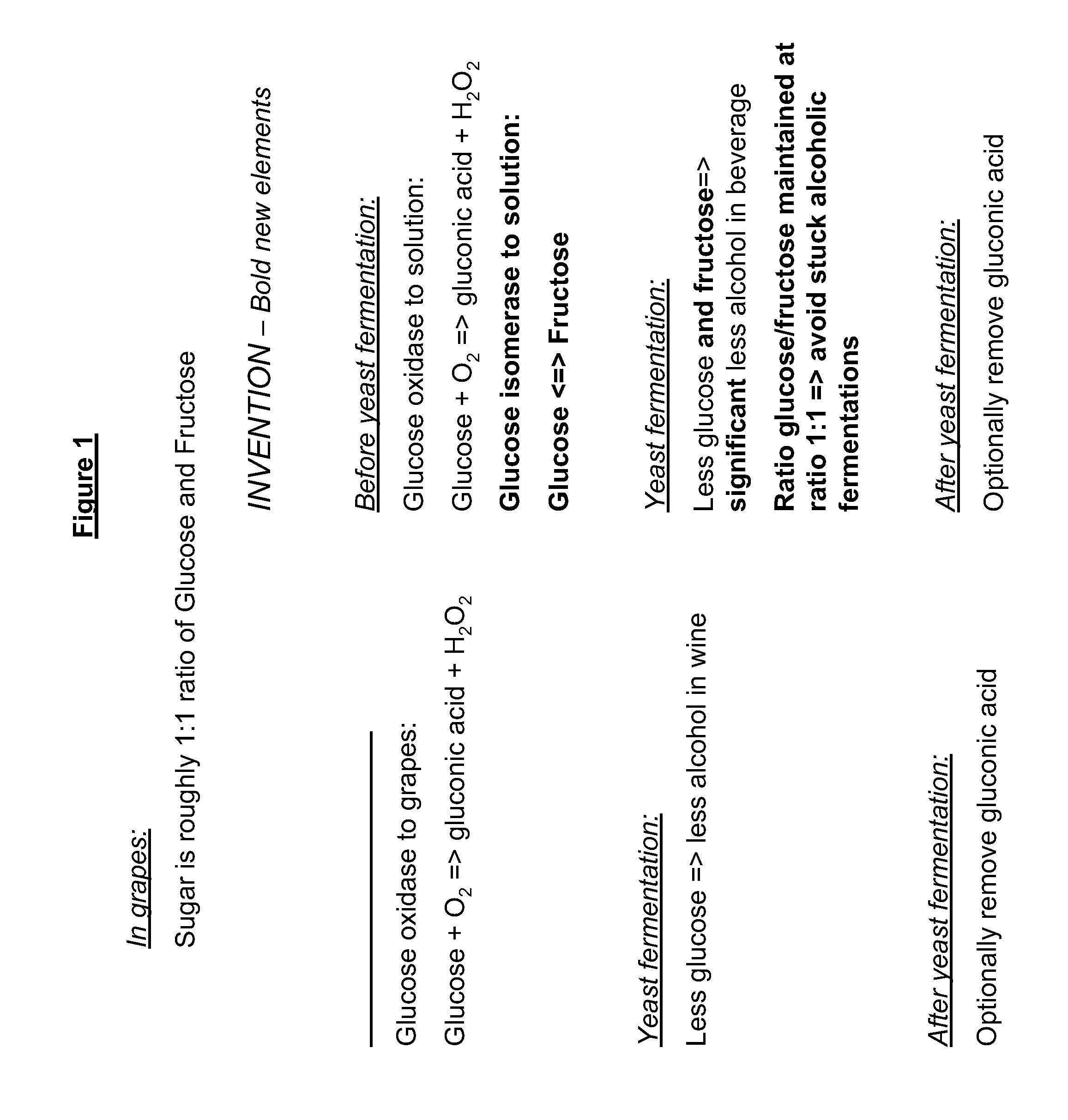Method for production of an alcoholic beverage with reduced content of alcohol
a technology of alcoholic beverages and content reduction, applied in the field of alcohol content reduction in alcoholic beverages, can solve the problems of significant reduction of etc., to reduce the content of alcohol, and reduce the risk of unwanted stuck alcoholic fermentation
- Summary
- Abstract
- Description
- Claims
- Application Information
AI Technical Summary
Benefits of technology
Problems solved by technology
Method used
Image
Examples
example 1
Enzymatic Sugar Reduction in Grape Juice—Example of Step (1) of First Aspect
[0106]One possible way to reduce the final alcohol content in beverages is to reduce the sugar concentration in the solution before the alcoholic fermentation. Therefore an enzymatic treatment of the solution, in this case grape juice, was performed in order to reduce the total sugar content.
[0107]Three independent experiments were performed using two replicates in each case. In each sample 200 ml grape juice (Pinot Blanc 2007, Germany, pasteurized) was added to a glass flask and continuously mixed with a magnetic stirrer. The samples were aerated throughout the experiment.
[0108]Either 100 mg glucose oxidase (Hyderase, Amano, >15,000 u / g, corresponding to 150,000 u per hl solution) or both 100 mg glucose oxidase and 1 g glucose isomerase (Sigma, G4166-50 g, >350 u / g, corresponding to 35,000 u per hl solution) were added to the flasks. The incubation was allowed to run at room temperature for 3 days.
[0109]Sam...
example 2
Yeast Fermentation of Treated Grape Juice—Example of Both Step (1) and Step (2) of First Aspect
[0112]A full simulation of a general beverage production process, in this case wine production, was done at laboratory scale. In this experiment it was shown that the enzymatic treatment did have an effect on the final alcohol level without negatively influencing major wine production parameters like the alcoholic fermentation or the malolactic fermentation.
[0113]The complete experiment was carried out at room temperature, approximately 22° C. Six experiments were performed with each four liters of grape juice (Pinot Blanc 2007, Germany, pasteurized) in fermentation flasks. The pH of the grape juice was not adjusted and no material was added other than the enzymes described in this example.
[0114]The grape juice was preincubated for three days with enzymes as described below, followed by the alcoholic fermentation of 11 days and a malolactic fermentation of 10 days.
[0115]Enzymatic Treatment...
example 3
Growth of Yeast During the Alcoholic Fermentation—Addition of Isomerase Significantly Reduces Stuck Alcoholic Fermentation
[0137]It is known to the skilled person that stuck fermentations typically arise when fructose concentrations are considerably higher than glucose concentrations. During the alcoholic fermentation the glucose / fructose ratio may change resulting in a delayed fermentation.
[0138]In this example 3 a delayed (stuck) fermentation was induced by treatment of the must with Glucose oxidase alone.
[0139]In order to investigate the effect of glucose isomerase on the ability of yeast to grow and survive during an alcoholic fermentation a simulated beverage production, in this case wine, was performed as described in Example 2 herein. The juice was pre-incubated for three days with enzymes as described below, followed by the alcoholic fermentation of 11 days and a malolactic fermentation of 10 days.
[0140]Three independent experiments were performed using two replicates in each...
PUM
 Login to View More
Login to View More Abstract
Description
Claims
Application Information
 Login to View More
Login to View More - R&D
- Intellectual Property
- Life Sciences
- Materials
- Tech Scout
- Unparalleled Data Quality
- Higher Quality Content
- 60% Fewer Hallucinations
Browse by: Latest US Patents, China's latest patents, Technical Efficacy Thesaurus, Application Domain, Technology Topic, Popular Technical Reports.
© 2025 PatSnap. All rights reserved.Legal|Privacy policy|Modern Slavery Act Transparency Statement|Sitemap|About US| Contact US: help@patsnap.com

